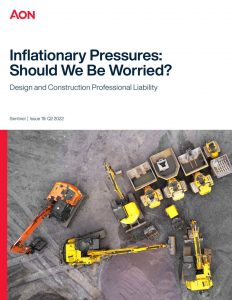Latest Aon North American market trends update highlights concerns over rising inflation.
The latest North American market trends update for architects and engineers published by financial services firm Aon, highlights increasing industry concerns over inflation which rose to 9.1% in June 2022 in the US, the highest rate for more than 40 years.
Reviewing the current state of play in the area of design and construction professional liability, Aon’s latest update, published in issue 19 of their Sentinel publication, concludes that although attention should be given to how inflation rates are impacting a client’s insurance rate, inflation should be embedded within the firm’s revenues and therefore any increase in insurance rates should be primarily based on increased risk, not general inflation.
The Aon update, Inflationary Pressures: Should We Be Worried?, makes the point that, as expected, the US and global economy has recovered quickly and in particular the engineering and construction (E&C) industry has responded well, with total construction spending in the US peaking at an annual rate of $1.57 trillion in July 2021, some 12% higher than 2019 average levels.
Estimates suggest that total US construction spending will increase to $1.701 trillion in 2022. The anticipated growth is in partial response to the passage of the US infrastructure bill, although the reality is that most of the funding will be disbursed annually in set amounts over a period of five to ten years.
In Canada, the Investing in Canada Plan (2016), a long-term federal infrastructure plan involving the investment of $188bn over 12 years, has seen 74,812 projects approved by November 2021 which represents $101bn in federal funding.

Despite the buoyant E&C industry, the impacts of the 2020 recession and the pandemic are still being felt with continued disruption in the supply chain, a sharp increase in construction costs and sub-contractor liquidity issues. Aon says that all these factors have increased the pressure on profitability, particularly for those firms which had negotiated fixed-price contracts.
Adding to the concerns is the sharp rise in inflation, recently reported as accelerating to 9.1% in June 2022 in the US, the highest since December 1981. In addition, the E&C marketplace has seen labour market shortages which can be partially attributed to a range of factors, including fear of both immunisation and infection, the lack of available/affordable daycare and the desire among many in the labour force to work remotely.
Aon’s update says that the labour and talent shortage means that there are less people on the job, which translates to project delays and cancellations, projects being scaled back, inability to respond to market needs and losing project bids, among other issues.
“While it would be logical to expect insured losses to increase in a period of near-record inflation, the losses experienced by the insurance industry over the past 24 months have accelerated at a much faster rate than can be explained by economic inflation,” Aon says.
Their update continues: “Attention should be given to how economic inflation rates impact a client’s insurance rate. To a great degree one could argue that the economic inflation is embedded within the firm’s revenues. Thus, any increase in rate should be primarily based on increased risk, not general inflation.”
According to Aon, it is rumoured that underwriters Lloyd’s of London is preparing a paper on the topic of inflation and it is likely it will have a significant effect upon how the Lloyd’s syndicates react going forward.
Should you wish to discuss any of the topics raised in this article, email Aon’s Michael Earp.


















